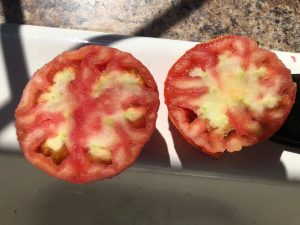A common problem tomato growers face this time of year are fruit defects caused by high temperatures. Heat stress on tomatoes can lead to reduced yield and abnormal fruit development. The common physiological disorders on fruit development under heat stress include yellow shoulder, internal white tissue, and blotchy ripening.
In a recent presentation by Gordon Johnson from the University of Delaware at the 2020 annual meeting of the American Society for Horticultural Science, he elaborated on the cause of internal white tissue in tomatoes, compared varieties, and provided suggestions to reduce the problem. Information in this article is summarized from this presentation and the tomato variety trial report by Gordon Johnson.
Tomato white tissue (Figure 1) develops when vascular tissue of the fruit is disturbed or damaged by heat so that the tissue turns white and the fruit has a bland taste. The fruit looks normal on the outside but may have severe internal defects. The variety trial compared 28 varieties from 5 companies in the summer of 2019. Commercial varieties that had the highest incidence of white tissue across five harvests were Camaro, Mountain Merit and Mountain Fresh. In addition to these varieties, Red Snapper had high white tissue incidence in the first harvest, and Grand Marshall and Myrtle had high incidence of white tissue in the late harvests. We noticed that some of the popular varieties in our area such as Primo Red, BHN 589, Red Deuce and Red Bounty ranked relatively low in the incidence of white tissue. In terms of marketable yield, the top commercial varieties were Grand Marshall, Red Snapper, Red Mountain and Red Bounty. Here is the full report about this variety trial.
Clearly, variety selection plays an important role in minimizing the white tissue problem. Gordon also suggested in his presentation that maintaining potassium levels in the plant is the key to reduce white tissue incidence. In the black plastic mulch system, soil temperatures might be so high that plant root function is reduced and potassium uptake is inadequate. By reducing soil temperature, white plastic mulch may help to reduce the problem for later planted tomatoes. In addition, applying additional potassium through the drip system or foliar application of potassium may help the problem. Using shade cloth to reduce temperature could also help reduce white tissue incidence.
